2009 CHEVROLET IMPALA spare tire
[x] Cancel search: spare tirePage 334 of 406
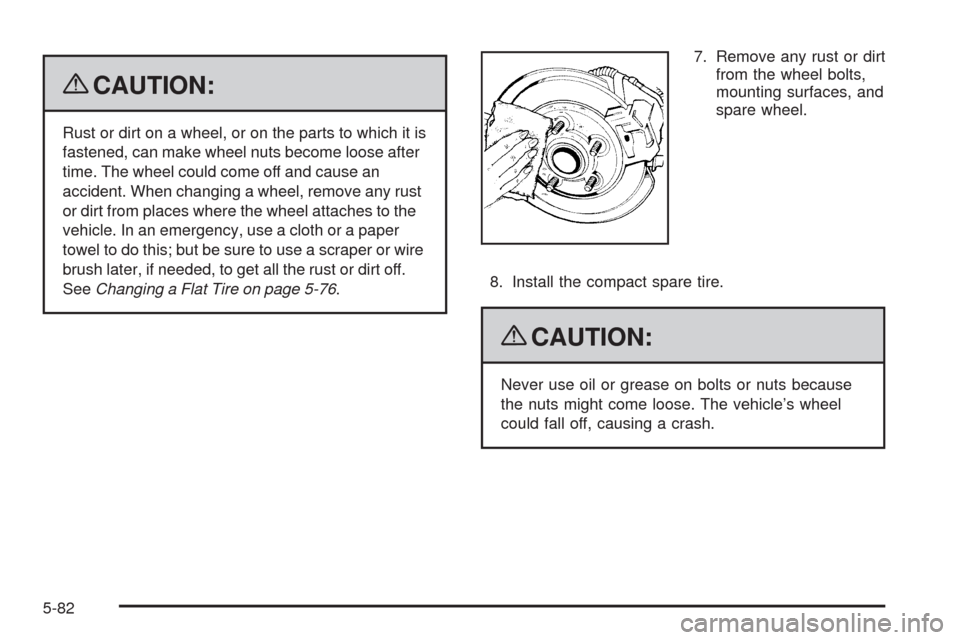
{CAUTION:
Rust or dirt on a wheel, or on the parts to which it is
fastened, can make wheel nuts become loose after
time. The wheel could come off and cause an
accident. When changing a wheel, remove any rust
or dirt from places where the wheel attaches to the
vehicle. In an emergency, use a cloth or a paper
towel to do this; but be sure to use a scraper or wire
brush later, if needed, to get all the rust or dirt off.
SeeChanging a Flat Tire on page 5-76.7. Remove any rust or dirt
from the wheel bolts,
mounting surfaces, and
spare wheel.
8. Install the compact spare tire.
{CAUTION:
Never use oil or grease on bolts or nuts because
the nuts might come loose. The vehicle’s wheel
could fall off, causing a crash.
5-82
Page 337 of 406
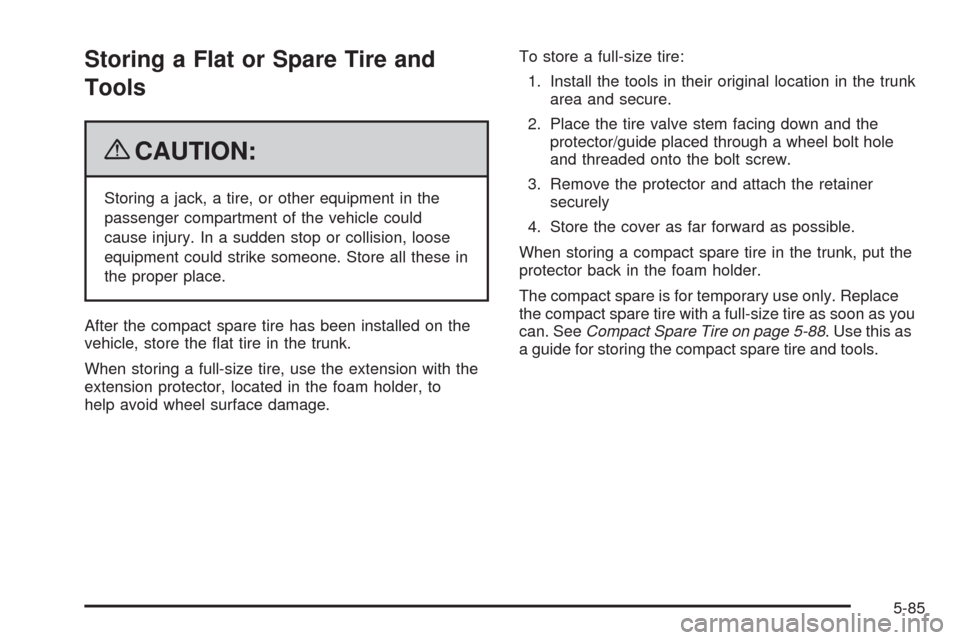
Storing a Flat or Spare Tire and
Tools
{CAUTION:
Storing a jack, a tire, or other equipment in the
passenger compartment of the vehicle could
cause injury. In a sudden stop or collision, loose
equipment could strike someone. Store all these in
the proper place.
After the compact spare tire has been installed on the
vehicle, store the �at tire in the trunk.
When storing a full-size tire, use the extension with the
extension protector, located in the foam holder, to
help avoid wheel surface damage.To store a full-size tire:
1. Install the tools in their original location in the trunk
area and secure.
2. Place the tire valve stem facing down and the
protector/guide placed through a wheel bolt hole
and threaded onto the bolt screw.
3. Remove the protector and attach the retainer
securely
4. Store the cover as far forward as possible.
When storing a compact spare tire in the trunk, put the
protector back in the foam holder.
The compact spare is for temporary use only. Replace
the compact spare tire with a full-size tire as soon as you
can. SeeCompact Spare Tire on page 5-88. Use this as
a guide for storing the compact spare tire and tools.
5-85
Page 338 of 406
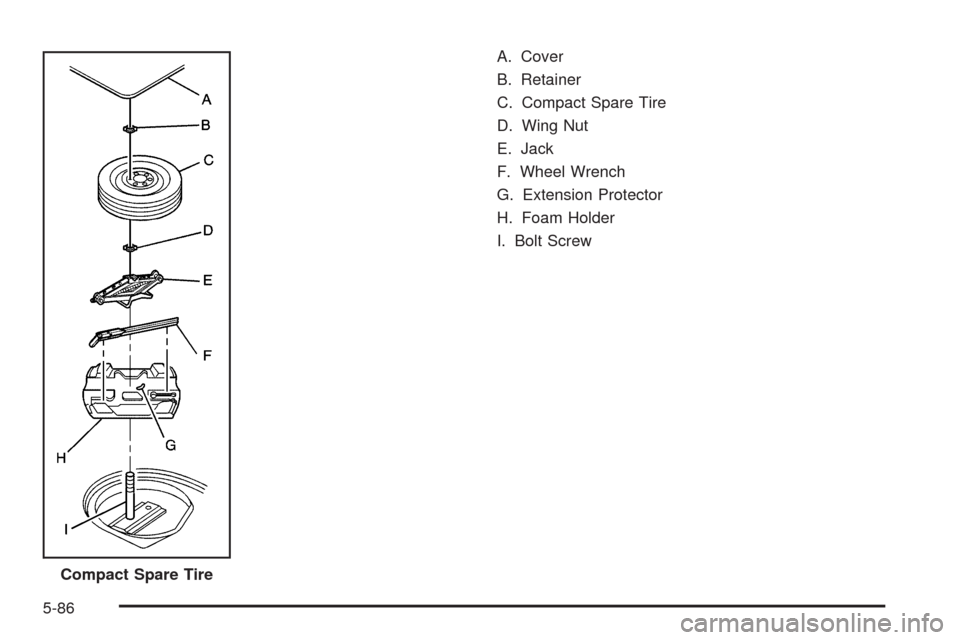
A. Cover
B. Retainer
C. Compact Spare Tire
D. Wing Nut
E. Jack
F. Wheel Wrench
G. Extension Protector
H. Foam Holder
I. Bolt Screw
Compact Spare Tire
5-86
Page 340 of 406
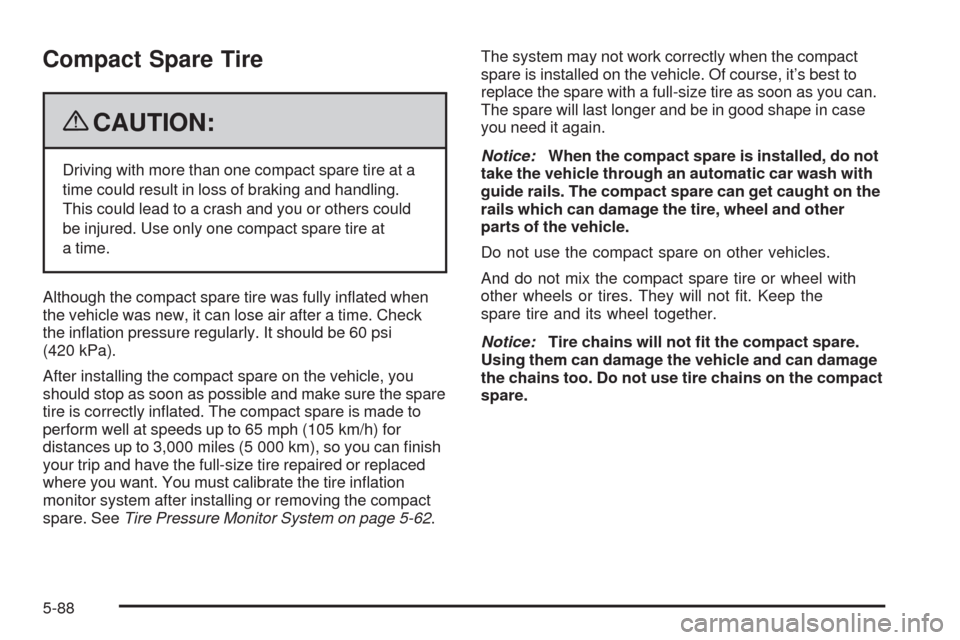
Compact Spare Tire
{CAUTION:
Driving with more than one compact spare tire at a
time could result in loss of braking and handling.
This could lead to a crash and you or others could
be injured. Use only one compact spare tire at
a time.
Although the compact spare tire was fully in�ated when
the vehicle was new, it can lose air after a time. Check
the in�ation pressure regularly. It should be 60 psi
(420 kPa).
After installing the compact spare on the vehicle, you
should stop as soon as possible and make sure the spare
tire is correctly in�ated. The compact spare is made to
perform well at speeds up to 65 mph (105 km/h) for
distances up to 3,000 miles (5 000 km), so you can �nish
your trip and have the full-size tire repaired or replaced
where you want. You must calibrate the tire in�ation
monitor system after installing or removing the compact
spare. SeeTire Pressure Monitor System on page 5-62.The system may not work correctly when the compact
spare is installed on the vehicle. Of course, it’s best to
replace the spare with a full-size tire as soon as you can.
The spare will last longer and be in good shape in case
you need it again.
Notice:When the compact spare is installed, do not
take the vehicle through an automatic car wash with
guide rails. The compact spare can get caught on the
rails which can damage the tire, wheel and other
parts of the vehicle.
Do not use the compact spare on other vehicles.
And do not mix the compact spare tire or wheel with
other wheels or tires. They will not �t. Keep the
spare tire and its wheel together.
Notice:Tire chains will not �t the compact spare.
Using them can damage the vehicle and can damage
the chains too. Do not use tire chains on the compact
spare.
5-88
Page 363 of 406
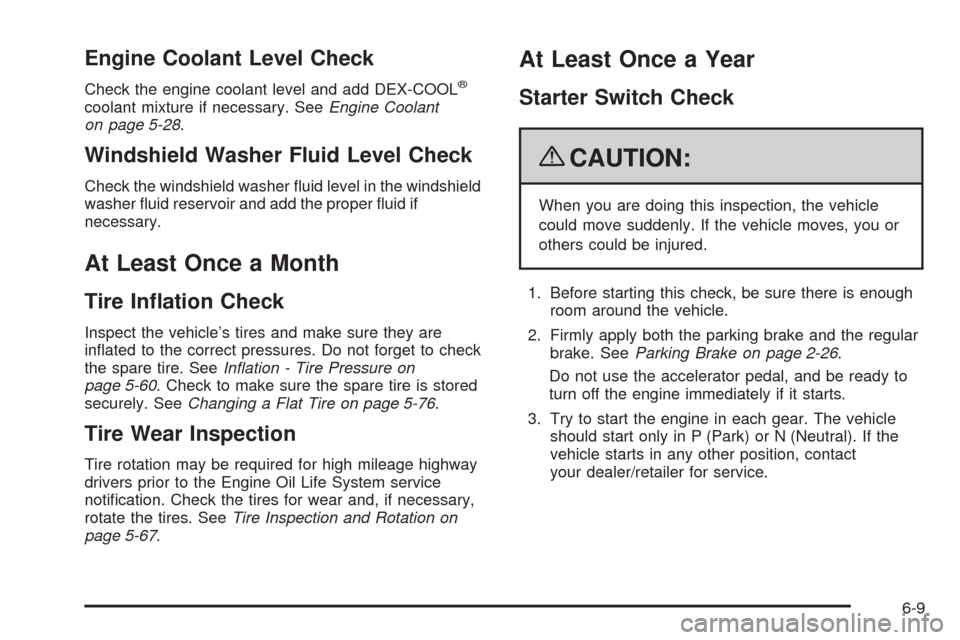
Engine Coolant Level Check
Check the engine coolant level and add DEX-COOL®
coolant mixture if necessary. SeeEngine Coolant
on page 5-28.
Windshield Washer Fluid Level Check
Check the windshield washer �uid level in the windshield
washer �uid reservoir and add the proper �uid if
necessary.
At Least Once a Month
Tire In�ation Check
Inspect the vehicle’s tires and make sure they are
in�ated to the correct pressures. Do not forget to check
the spare tire. SeeInflation - Tire Pressure on
page 5-60. Check to make sure the spare tire is stored
securely. SeeChanging a Flat Tire on page 5-76.
Tire Wear Inspection
Tire rotation may be required for high mileage highway
drivers prior to the Engine Oil Life System service
noti�cation. Check the tires for wear and, if necessary,
rotate the tires. SeeTire Inspection and Rotation on
page 5-67.
At Least Once a Year
Starter Switch Check
{CAUTION:
When you are doing this inspection, the vehicle
could move suddenly. If the vehicle moves, you or
others could be injured.
1. Before starting this check, be sure there is enough
room around the vehicle.
2. Firmly apply both the parking brake and the regular
brake. SeeParking Brake on page 2-26.
Do not use the accelerator pedal, and be ready to
turn off the engine immediately if it starts.
3. Try to start the engine in each gear. The vehicle
should start only in P (Park) or N (Neutral). If the
vehicle starts in any other position, contact
your dealer/retailer for service.
6-9
Page 381 of 406
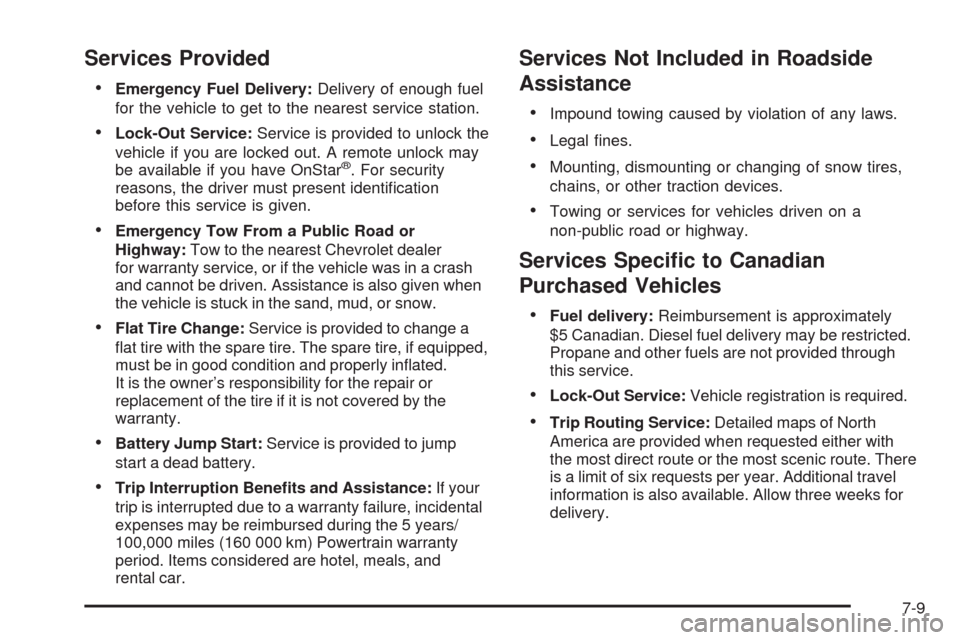
Services Provided
Emergency Fuel Delivery:Delivery of enough fuel
for the vehicle to get to the nearest service station.
Lock-Out Service:Service is provided to unlock the
vehicle if you are locked out. A remote unlock may
be available if you have OnStar
®. For security
reasons, the driver must present identi�cation
before this service is given.
Emergency Tow From a Public Road or
Highway:Tow to the nearest Chevrolet dealer
for warranty service, or if the vehicle was in a crash
and cannot be driven. Assistance is also given when
the vehicle is stuck in the sand, mud, or snow.
Flat Tire Change:Service is provided to change a
�at tire with the spare tire. The spare tire, if equipped,
must be in good condition and properly in�ated.
It is the owner’s responsibility for the repair or
replacement of the tire if it is not covered by the
warranty.
Battery Jump Start:Service is provided to jump
start a dead battery.
Trip Interruption Bene�ts and Assistance:If your
trip is interrupted due to a warranty failure, incidental
expenses may be reimbursed during the 5 years/
100,000 miles (160 000 km) Powertrain warranty
period. Items considered are hotel, meals, and
rental car.
Services Not Included in Roadside
Assistance
Impound towing caused by violation of any laws.
Legal �nes.
Mounting, dismounting or changing of snow tires,
chains, or other traction devices.
Towing or services for vehicles driven on a
non-public road or highway.
Services Speci�c to Canadian
Purchased Vehicles
Fuel delivery:Reimbursement is approximately
$5 Canadian. Diesel fuel delivery may be restricted.
Propane and other fuels are not provided through
this service.
Lock-Out Service:Vehicle registration is required.
Trip Routing Service:Detailed maps of North
America are provided when requested either with
the most direct route or the most scenic route. There
is a limit of six requests per year. Additional travel
information is also available. Allow three weeks for
delivery.
7-9
Page 395 of 406
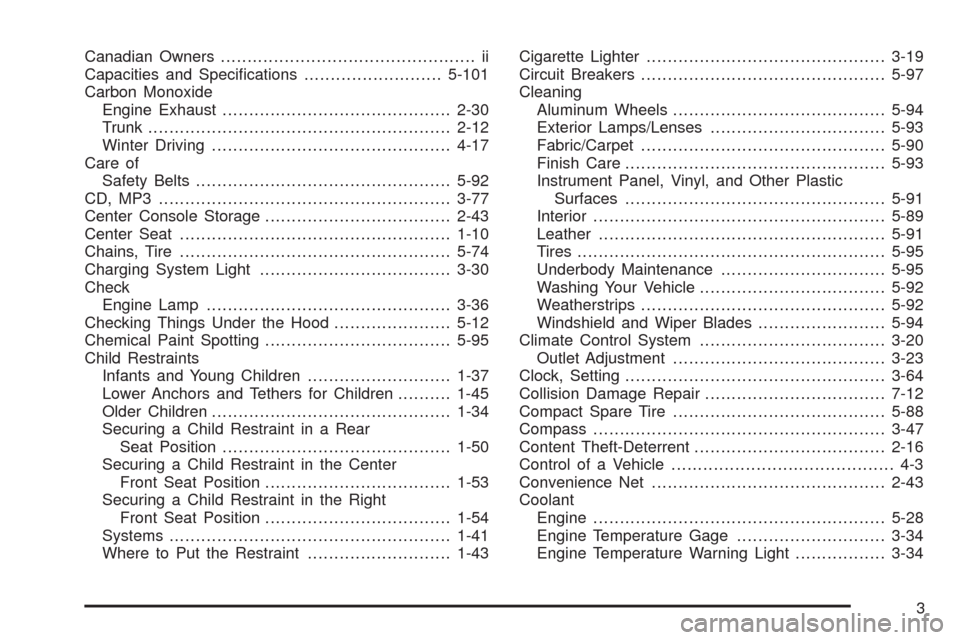
Canadian Owners................................................ ii
Capacities and Speci�cations..........................5-101
Carbon Monoxide
Engine Exhaust...........................................2-30
Trunk.........................................................2-12
Winter Driving.............................................4-17
Care of
Safety Belts................................................5-92
CD, MP3 .......................................................3-77
Center Console Storage...................................2-43
Center Seat...................................................1-10
Chains, Tire...................................................5-74
Charging System Light....................................3-30
Check
Engine Lamp..............................................3-36
Checking Things Under the Hood......................5-12
Chemical Paint Spotting...................................5-95
Child Restraints
Infants and Young Children...........................1-37
Lower Anchors and Tethers for Children..........1-45
Older Children.............................................1-34
Securing a Child Restraint in a Rear
Seat Position...........................................1-50
Securing a Child Restraint in the Center
Front Seat Position...................................1-53
Securing a Child Restraint in the Right
Front Seat Position...................................1-54
Systems.....................................................1-41
Where to Put the Restraint...........................1-43Cigarette Lighter.............................................3-19
Circuit Breakers..............................................5-97
Cleaning
Aluminum Wheels........................................5-94
Exterior Lamps/Lenses.................................5-93
Fabric/Carpet..............................................5-90
Finish Care.................................................5-93
Instrument Panel, Vinyl, and Other Plastic
Surfaces.................................................5-91
Interior.......................................................5-89
Leather......................................................5-91
Tires
..........................................................5-95
Underbody Maintenance...............................5-95
Washing Your Vehicle...................................5-92
Weatherstrips..............................................5-92
Windshield and Wiper Blades........................5-94
Climate Control System...................................3-20
Outlet Adjustment........................................3-23
Clock, Setting.................................................3-64
Collision Damage Repair..................................7-12
Compact Spare Tire........................................5-88
Compass.......................................................3-47
Content Theft-Deterrent....................................2-16
Control of a Vehicle.......................................... 4-3
Convenience Net............................................2-43
Coolant
Engine.......................................................5-28
Engine Temperature Gage............................3-34
Engine Temperature Warning Light.................3-34
3
Page 402 of 406
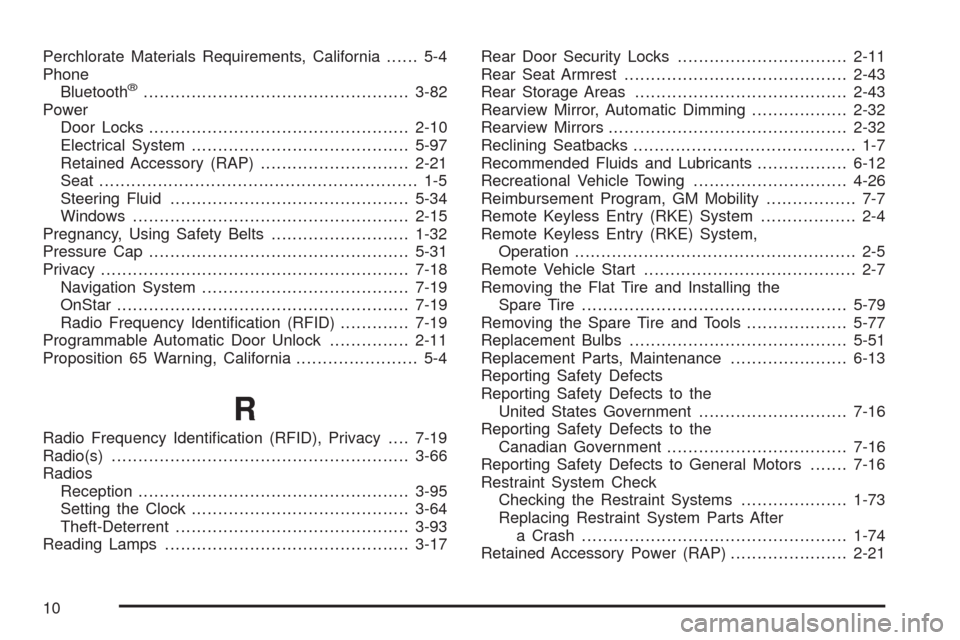
Perchlorate Materials Requirements, California...... 5-4
Phone
Bluetooth
®..................................................3-82
Power
Door Locks.................................................2-10
Electrical System.........................................5-97
Retained Accessory (RAP)............................2-21
Seat ............................................................ 1-5
Steering Fluid.............................................5-34
Windows....................................................2-15
Pregnancy, Using Safety Belts..........................1-32
Pressure Cap.................................................5-31
Privacy..........................................................7-18
Navigation System.......................................7-19
OnStar .......................................................7-19
Radio Frequency Identi�cation (RFID).............7-19
Programmable Automatic Door Unlock...............2-11
Proposition 65 Warning, California....................... 5-4
R
Radio Frequency Identi�cation (RFID), Privacy....7-19
Radio(s)........................................................3-66
Radios
Reception...................................................3-95
Setting the Clock.........................................3-64
Theft-Deterrent............................................3-93
Reading Lamps..............................................3-17Rear Door Security Locks................................2-11
Rear Seat Armrest..........................................2-43
Rear Storage Areas........................................2-43
Rearview Mirror, Automatic Dimming..................2-32
Rearview Mirrors.............................................2-32
Reclining Seatbacks.......................................... 1-7
Recommended Fluids and Lubricants.................6-12
Recreational Vehicle Towing.............................4-26
Reimbursement Program, GM Mobility................. 7-7
Remote Keyless Entry (RKE) System.................. 2-4
Remote Keyless Entry (RKE) System,
Operation..................................................... 2-5
Remote Vehicle Start........................................ 2-7
Removing the Flat Tire and Installing the
Spare Tire..................................................5-79
Removing the Spare Tire and Tools...................5-77
Replacement Bulbs.........................................5-51
Replacement Parts, Maintenance......................6-13
Reporting Safety Defects
Reporting Safety Defects to the
United States Government............................7-16
Reporting Safety Defects to the
Canadian Government..................................7-16
Reporting Safety Defects to General Motors.......7-16
Restraint System Check
Checking the Restraint Systems....................1-73
Replacing Restraint System Parts After
a Crash..................................................1-74
Retained Accessory Power (RAP)......................2-21
10